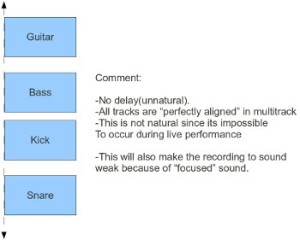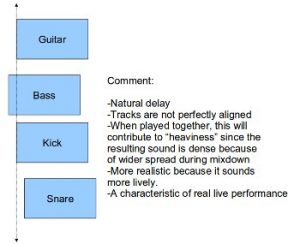Natural delay is a result of natural recording. This is not visible in normal view, you need to zoom it to the max and then you will notice that a naturally recorded tracks is not “perfectly aligned” instead it has a some delay on it. When you are mixing on digital platforms, you may be tempted to align all tracks “perfectly” . However; these very slight acceptable delays can sometimes contributes to the overall density of the mix. This how it looks like:
As expected, a natural delay between instrumenst in a rock mix is very helpful in providing additional density to the music. When played together in unison, a slight delay can spread out the overall sound thus making it sound heavy.
Tip#4: Experiment with natural reverb instead of artificial reverbs. Natural reverb is captured naturally when recording using microphones. For example if you are recording guitars using microphones and amps, you will have an opportunity to capture the ambiance/reverb properties of the room where the guitar is recorded. This natural reverb is beneficial in rock music since it adds more warm and depth without squashing the mix with artificial reverb settings. The same is true for the drums, bass and even vocals. Recording the drums in a cemented floor, concrete walls and small sized room can capture the tightness of the drum sound appropriate for rock.
Tip#5: Low mixdown volume is LOUD
You will be surprised. If you will mixdown at a lower volume say -3dB to -6dB, you will have more chances that the rock music you are mixing is going to be definitely louder and sounds very nice after mastering compared to a loud mixdown(-1dB or no headroom at all). It’s because mastering engineers can apply optimal compression and limiter settings to an uncompressed material much better than an already compressed material. The end result is a very loud, dense and heavy rock music.
Content last updated on June 17, 2012

